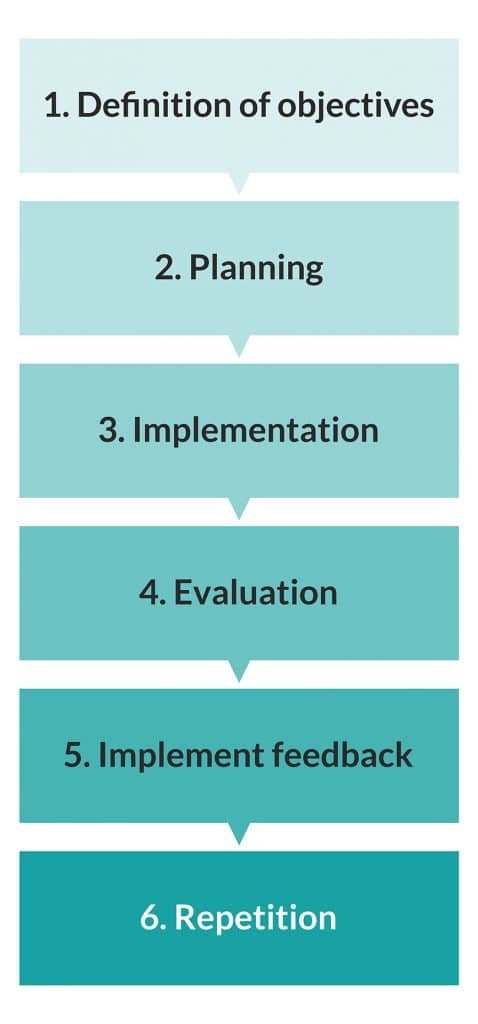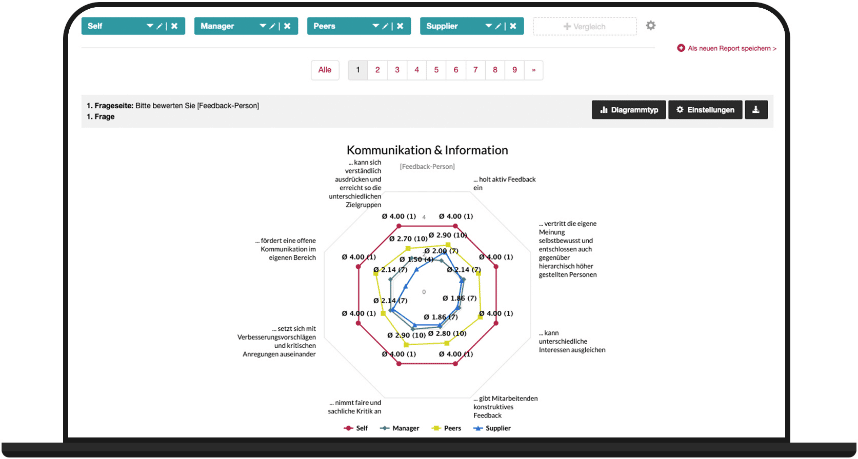360 degree feedback process


Solutions / 360 Degree Feedback / 360 degree feedback process
The implementation of a 360 degree feedback process and success is divided into 6 phases.

- Phase: Objective
- Phase: Planning
- Phase: Execution
- Phase: Evaluation
- Phase: Implementing feedback
- Phase: Repetition
1st phase: Objective
The first phase is about setting objectives:
What is the aim of 360-degree feedback?
As a rule, the aim is to help the people being assessed to develop further. However, there may be other objectives behind this, such as improving the management culture or establishing feedback management.
The clearer the goal is formulated, the more concretely the next steps can be tackled.

It is important that the objectives of the feedback process are clearly communicated from the outset and understood by all participants.
This is the only way to ensure that the feedback participants are actively involved in achieving these goals and that the results of the feedback can be interpreted accordingly.
Clear objectives also make it possible to align the selection of feedback providers, the design of the questionnaires and the interpretation of the results with the defined objectives.
This makes the entire feedback process more effective and goal-oriented.
2nd phase: Planning
The next step is to plan the survey.
For example, when should the survey be conducted? What is the right time?
It is best to also take into account more labor-intensive phases, such as those that occur in accounting at the end of the year.
This will help you avoid stressed employees, a low participation rate or half-hearted responses due to a lack of time.
It is advisable to choose a period that is as stress-free as possible for everyone involved and allows sufficient time for careful processing of the feedback forms.
This may mean conducting the survey outside of peak times or particularly busy periods to ensure that employees have sufficient time and peace of mind to engage with the questions and provide quality responses.
Careful planning and timing will help to maximize the effectiveness and validity of the feedback process.
3rd phase: Execution
The preparation phase is complete. Now it’s time to get started. By clicking on the send button, all participants are invited to provide 360-degree feedback.
It makes sense if all groups of people are invited at the same time, so that a consistent value is conveyed.
Also remember to send a reminder email in good time to remind those who did not want to or were unable to take part straight away.
A friendly reminder can help to increase the participation rate and ensure that as much feedback as possible is received, which significantly improves the validity of the feedback.
4th phase: Evaluation
In the so-called reporting phase, all questionnaires received are evaluated.
This is much easier with an online survey than with a manual one.
easyfeedback does the work for you here, as the reports are created automatically for each manager and no manual effort is required on your part.

The automatic generation of reports provides you with a clear comparison of the individual perspectives at a glance.
This comprehensive presentation enables you to quickly gain insights into the strengths and development areas of the managers assessed.
With this data, you can now begin to interpret the results and derive targeted measures to further develop and strengthen the managers’ skills.
The automated evaluation not only facilitates the process, but also enables efficient and well-founded decision-making based on the feedback results.
5th phase: Implement feedback
Of course, it should not just be about evaluating the results.
Feedback is only effective if it is followed up by implementation.
This can be done in discussions with the manager, in which the results are discussed with the evaluated employee.

In this way, joint strategies can be developed to promote potential and compensate for weaknesses.
These discussions should be designed as a supportive dialog that offers space for openness, reflection and mutual understanding.
It is important that the manager has the opportunity to express their views on the feedback received and clarify any misunderstandings.
Specific measures can then be agreed upon together with the aim of addressing the identified development areas in a targeted manner and building on strengths.
This dialog process not only promotes the personal and professional development of the manager, but also strengthens trust and cooperation within the team.
6th phase: Repetition
In order to measure the effectiveness of the changes made, it makes sense to repeat the 360-degree feedback after a period of around 6 months.
This makes it possible to determine whether the feedback has contributed to an improvement in the situation and whether the agreed measures have achieved the desired results.
The repeat survey can identify changes and progress in the behavior and perception of the manager and in the team environment.
This makes it possible to continuously monitor the development process and make adjustments where necessary to ensure that the desired goals are achieved.
In addition, the regular implementation of 360-degree feedback helps to establish a feedback culture within the company and promote awareness of continuous improvement.
Further information


